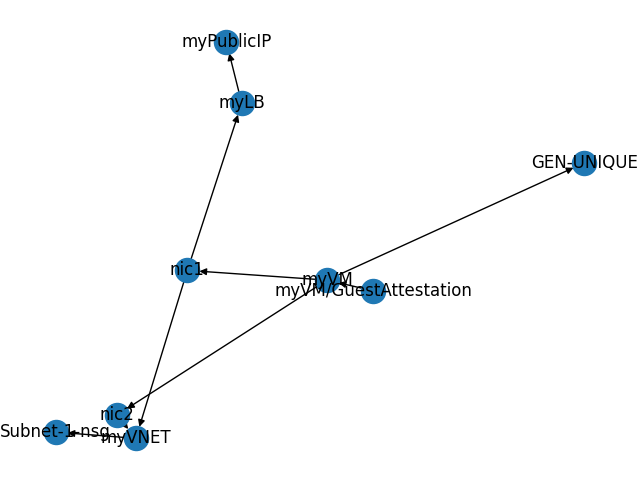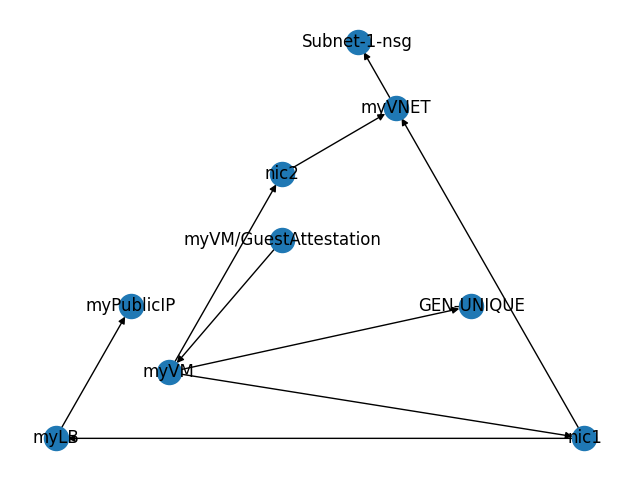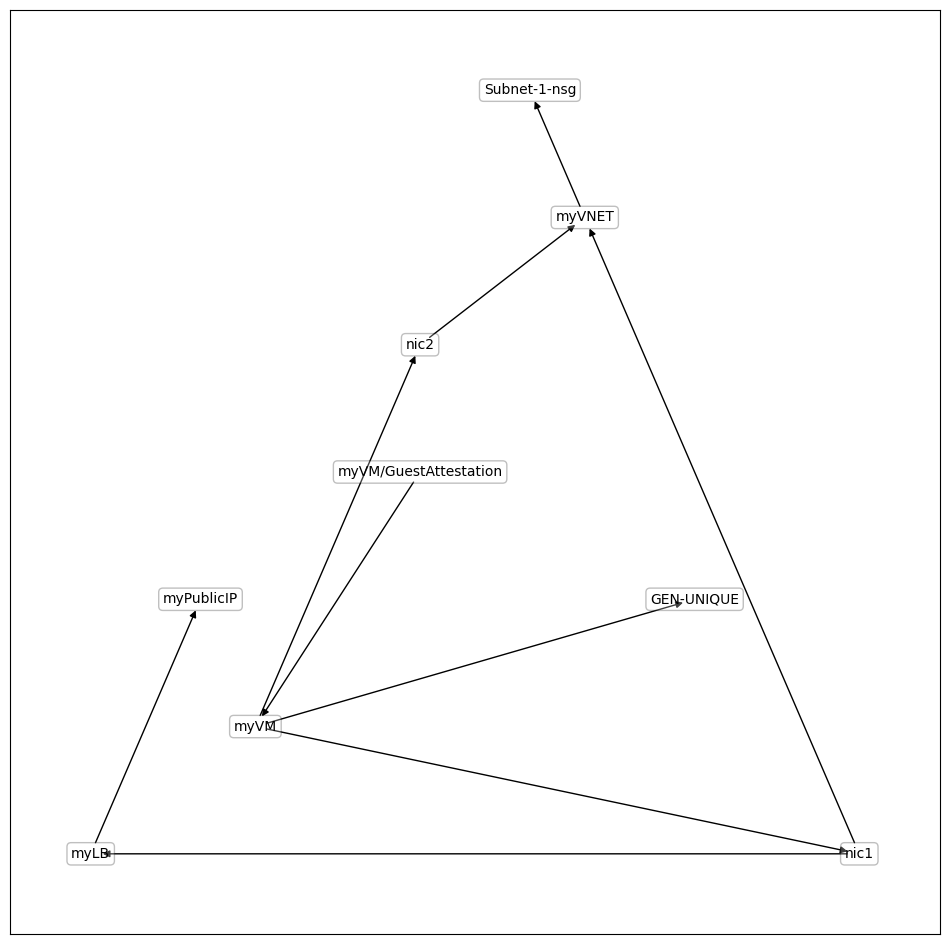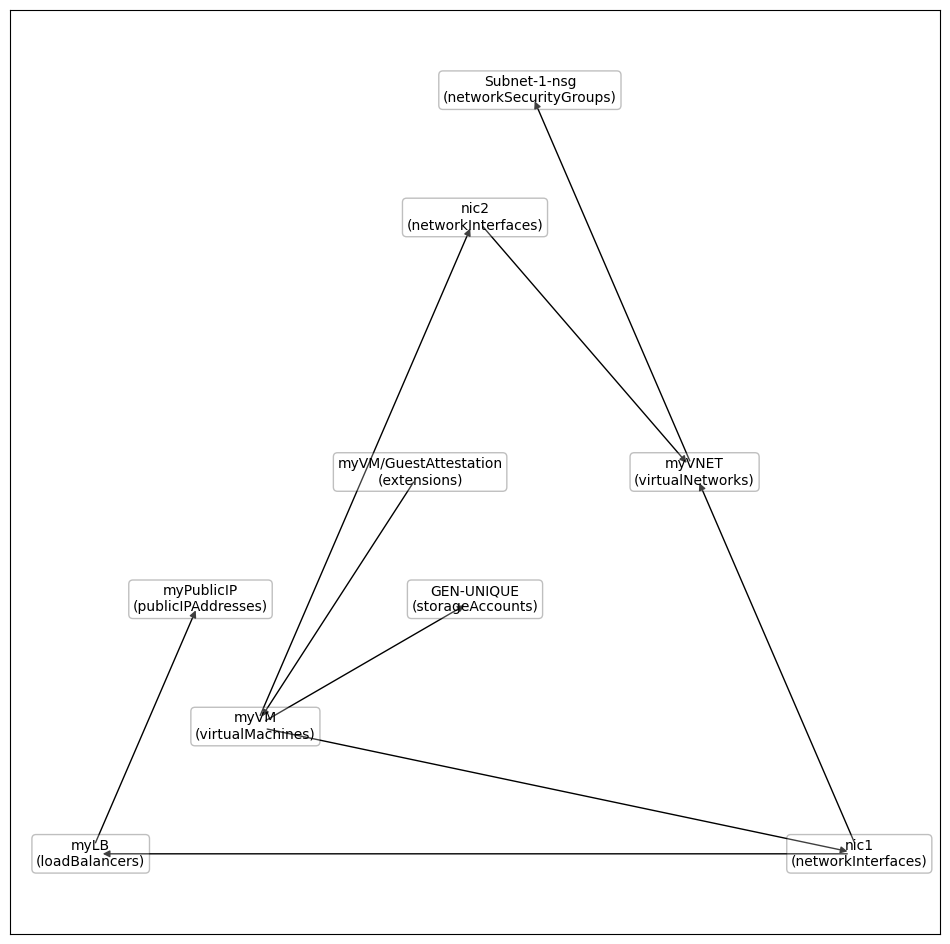Introduction
In this blog, I want to talk about how to leverage az cli to visualize a graph in Python. Note that Azure portal has a tab that shows the visualization of the resources. The reason why I am still interested in this topic is that I want to turn azure resource definition into a data structure, which can then be leveraged to generate different form of diagrams:
- dependency graph of azure resources
- data flow diagram (for threat modeling)
- mermaid diagram (for documentation)
- sequence diagram (need to get sequence information from users)
There are also other tools for visualizing azure resources:
Parser
At first, I want to build my own parsing library using open source library like chevrotain. I can build a lexer and a grammar and then turn azure resource definition file into AST (abstract syntax tree).
But hey, there’s already an official library: arm-template-parser. Do not reinvent the wheel!
The parser is a cli tool. I download the executables and it is named Template.Parser.Cli.
This is how you invoke the program:
$sourcePath = "./example-template.json"
$parametersSourcePath = "./example-template.param.json"
.\Template.Parser.Cli.exe -s $sourcePath -f $parametersSourcePath -a
Note:
sourcePath: the azure resource templateparametersSourcePath: the parameters-ais to show all resources, otherwise, the cli only returns one resource
I use subprocess to execute the program:
# .env
az_tool_exe_path="C:/Users/huijinghuang/source/hacks/Template.Parser.Cli.exe"
# command.py
import subprocess
from typing import List
def run(args: List[str]):
"""Run a command with the given arguments and return the result.
The returned object:
- result.stdout contains the output of the command execution.
- result.stderr contains the error of the command execution
Example:
run(["ls", "-l"])
# Output:
# total 8
Args:
args (List[str]): List of command and arguments
Returns:
CompletedProcess: The result of the command execution
Raises:
subprocess.CalledProcessError: If the command execution fails
"""
try:
result = subprocess.run(
args,
check=True,
capture_output=True,
text=True)
return result
except subprocess.CalledProcessError as e:
print(f"Execiton Error: {e}")
# main.py
def execute():
# Run the azure cli command to parse the azure sources definition
exe_path = settings.az_tool_exe_path
params = ["-s", source_template_filepath, "-f", parameters_filepath, "-a"]
args = [exe_path] + params
result = run(args)
resources = json.loads(result.stdout)
Visualization
Once I have the compiled azure resources file, I then build a dependency graph. I use networkx for building graph and matplotlib for displyaing the result.
def create_graph(resources: Dict[str, Any]):
"""
Create a dependency graph from the resources.
Args:
resources (Dict[str, Any]): The resources definition in json format
"""
# Create a directed graph
G = nx.DiGraph()
names = []
# Add nodes
for resource in resources:
name = resource.get("name")
names.append(name)
G.add_node(name)
# Add edges
for resource in resources:
src = resource.get("name")
depends = resource.get("dependsOn", [])
for dependency in depends:
# Find the correct name in the names list that matches the suffix
dst = next((name for name in names if dependency.endswith(name)), None)
assert dst is not None, f"Resource {dependency} not found"
G.add_edge(src, dst)
return G
Once I have the graph, I then call matplotlib to show the graph:
# Draw the graph
nx.draw(G, with_labels=True)
plt.show()
Here’s an example output:

This graph looks ugly.
I want to apply topological sort the graph:
# Apply a topological sort to the graph
sorted_nodes = list(nx.topological_sort(G))
# Create a position dictionary based on the topological sort order
pos = {node: (i, 0) for i, node in enumerate(sorted_nodes)}
# Draw the graph with the custom positions
nx.draw(G, pos, with_labels=True)
plt.show()
The order is now great, but, it is now linear:

Well, the best I can do so far is to use the planner layout:
pos = nx.planar_layout(G)
nx.draw(G, pos, with_labels=True)
plt.show()

I then made the following adjustment to the images:
- get rid of node color
- draw box around labels
- make the labels transparent
- increase the image size
def save_graph_image(G, file_path):
plt.figure(figsize=(12, 12)) # Increase figure size to prevent cutting off text and shapes
pos = nx.planar_layout(G)
# Draw nodes with custom settings
nx.draw_networkx_nodes(G, pos, node_size=3000, node_color="none", node_shape="s")
# Draw labels with bounding box to fit text within nodes
nx.draw_networkx_labels(G, pos, font_size=10, bbox=dict(facecolor='white', alpha=0.25, edgecolor='black', boxstyle='round,pad=0.3'))
# Draw edges
nx.draw_networkx_edges(G, pos, arrowstyle='-|>', arrowsize=10)
plt.savefig(file_path, bbox_inches='tight') # Save the figure with tight bounding box
plt.close()

I also enhance the diagram with a name_type mapping information.
# Create custom labels with both name and type
# Since the type is too verbose, I am going to only display the last part
# For example:
# Microsoft.Network/virtualNetworks => virtualNetworks
name_type_sim = {name: type.split("/")[-1] for name, type in name_type.items()}
labels = {node: f"{node}\n({name_type_sim[node]})" for node in G.nodes()}
# ...
# Draw labels with bounding box to fit text within nodes
nx.draw_networkx_labels(G, pos, labels=labels, font_size=10, bbox=dict(facecolor='white', alpha=0.25, edgecolor='black', boxstyle='round,pad=0.3'))
